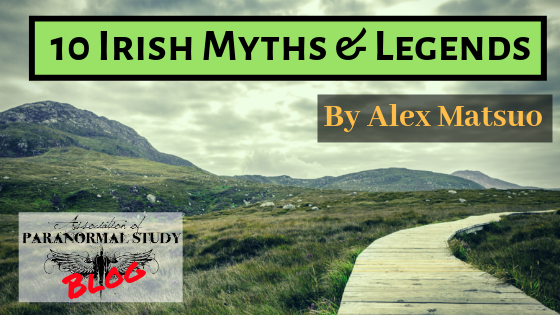Ireland is a country that is rich in culture, history, myths, and legends. Some of our best known myths and legends came from Ireland! You could say that Ireland’s myths and legends have laid the foundation for our society today. The Druids and the Celtics had a strong belief in magic and the power of the Earth, and those beliefs were passed on throughout the different generations and survived thanks to oral tradition and eventually the innovation of the printing press. Thankfully, these legends survived as the Irish were converting to Christianity, and we can appreciate them today.
Previously, we have written about the legend of the leprechaun as well as the banshee and we have even written about selkies. To celebrate St. Patrick’s Day 2019, we’re going to talk about some of the other famous Irish myths and legends that tend to get upstaged by the leprechaun and shamrock. Please tell us about the Irish myths and legends you know about in the comments!
Cú Chulainn
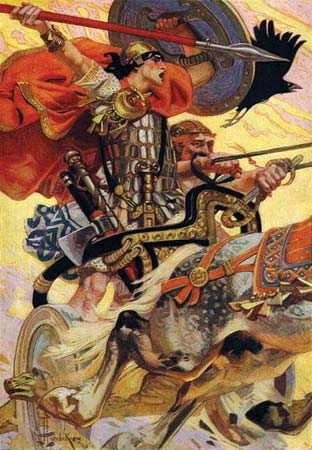
Sometimes known as Cuhullin, Cú Chulainn is one of the most famous Irish legends known today. He is a mythological hero who appears in the stories of the Ulster Cycle, plus the Scottish and Manx folklore. His birth name was Sentant, but e gain the name after slaying a dangerous guard dog that belonged to Culann. Before you deiced that you don’t like him, apparently the dog was slain in self-defense. His name literally translates to ‘Culann’s Hound’. His father was the god Lugh and his mother was a mortal by the name of Deichtine. You could almost say he’s the Irish version of the Greek mythological figure, Hercules. To give you an idea of how to find his stories, look in the Ulster Cycle, which is formerly known as the Red Branch Cycle. There are four cycles of Irish mythology that comprise of sagas and heroic legends. What is interesting about Cú Chulainn is that he possessed something called a “ríastrad”, meaning whenever he fights, he turned into this battle-thirsty monster that knows neither friend or foe. He possessed superhuman strength and agility, making him useful in war. He joined his uncle’s army, the Red Branch Knights, his uncle being King Conchobar Mac Nessa.
Dagda’s Harp
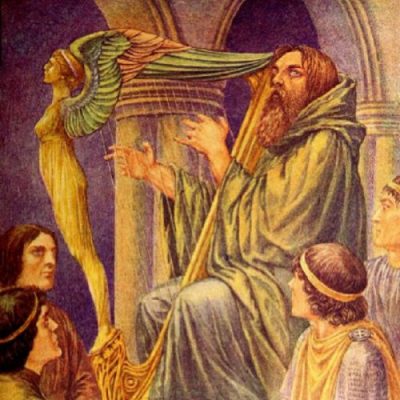
The Dagda was a god who was part of the Tuatha de Dannan who had a cauldron of plenty, meaning that regardless of how many men sat with him, there would always be plenty of food. He also possessed a magic club where one end would end a man’s life, and the other end could restore life. The most famous item the Dagda possessed was a harp known as the Uaithne, called the Four-Angled Music. The Dagda could make the seasons come in the correct order as well as make people laugh or cry. Before battle, the Dagda would play the harp for his men to make their fears go away. After a day of fighting, he would play the harp to help his men forget their sorrow of losing their fellow fighters and feel the joy of victory. The Fomorians heard of this harp. And when they were preparing to fight the Tuatha de Dannan in the second Battle of Moytura, they decided to steal the harp in hopes it would help them win the battle. A few of the warriors stole the harp and hid in the cave until the battle was over. Unfortunately for the Fomorians, they lost the battle. When the Tuatha de Dannan returned from the fight, they begged Dagda to play his harp. When it couldn’t be found, Dagda, Ogman, and Lugh went to find the harp. When the three gods arrived at the cave, Dagda stretched out his arm and the harp was returned to him. When the Fomorians picked up their weapons, Lugh told Dagda to play a song. So he played a song to make them laugh. When he was done, the Fomorians picked their weapons back up. Then Dagda played a song to make them cry; same result. Finally, Dagda played a song to make the Fomorians fall asleep, and it worked. You can bet that no one stole Dagda’s harp ever again!
Changelings

In case you didn’t know, changelings are a European myth, and Ireland was no exception! Changelings are rather disturbing. They usually came from fairies, and they were the deformed children of these creatures. Since fairies prefer a more aesthetically pleasing baby, they would steal human babies and swap them out with their changelings. These changelings look like human babies, but they get pleasure out of other people’s miseries and they are emotionally void of feeling happiness for others unless they are suffering. In Irish folklore, looking at a baby with admiration, jealously, or anything that elevated the baby’s status would be dangerous. Basically putting your baby on some sort of pedestal in admiration made it more vulnerable to be kidnapped. Changelings were also believed to be old fairies who were brought into the human world to die. A way to combat changelings would be to throw it in the fire and it would jump up the chimney and the fairies would return the baby. If you shouted “God bless you” while a fairy was trying to kidnap your baby, it would abandon its plans and leave. There are even stories of fairies returning human babies and asking for their changelings back.
Giant’s Causeway

The Giant’s Causeway is very much a real place and you can visit it! It is located on the Northern coast of Ireland and it is just a few miles northeast of the town of Bushmills. The causeway has about 40,000 interlocking basalt columns, and they look like they were made by a giant. Hence the legend we’re about to talk about. The columns have a hexagonal shape, and they are the result of an ancient volcanic fissure eruption that occurred about 50 million years ago. Isn’t Mother Nature amazing? But people back in ancient times didn’t have the knowledge of geology as we do today. As said a few times in our blogs, humans created myths and legends to explain the things that we didn’t understand. UNESCO declared the area as a World Heritage Site and the 4th greatest natural wonder in the world in the United Kingdom. Legend has it (in the Fenian Cycle) that Finn Mac Cool built the causeway as a bridge to Scotland after the giant, Benandonner, challenged him to a fight. There are a few variations of the legend, like Finn defeating Benandonner. However, my favorite is the one where Finn’s wife, Oonagh, helps him hide by disguising him as a baby. Basically, Finn realized that Benandonner was a lot bigger than expected and didn’t want to fight. When Benandonner arrives, Oonagh invites him inside while he waits for Finn. When he sees the “baby”, Benandonner freaks out because the baby is huge, which means his father must be much bigger. Then, Benandonner runs back to Scotland, destroying the bridge behind him and cutting off Ireland from Scotland.
The Blarney Stone
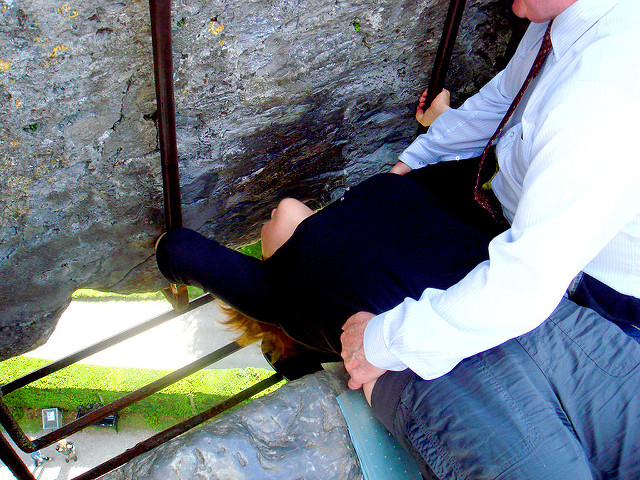
The Blarney Stone is considered a “must do” activity when visiting Ireland. For over 200 years, millions of people have climbed the steps of the Blarney Castle and kissed the famous stone known for giving the gift of eloquence. The stone was set in a tower in 1446. Some of the legends behind the Blarney Stone include it being Jacob’s Pillow, otherwise known as the Stone of Jacob. It was brought to Ireland by Jeremiah (the Prophet). It was renamed as the Fatal Stone and used as an oracular throne of Irish kings. It is also believed to be the deathbed pillow of St. Columba of Iona. Then the stone was taken to Ireland and its prophetic power was used for royal succession, known as the Stone of Destiny. When the Irish went to aid Robert the Bruce in 1314, part of the Blarney Stone was returned to Ireland and set in the castle where it sits today. Other legends state the Blarney Stone was stone that Moses struck and gushed water. Others believe that it was called the “Stone of Ezel” at first and brought back to Ireland from the Crusades. Finally, one last legend, is about the Lord of Blarney, Cormac Teige McCarthy, who was going to have his land taken away from Elizabeth I. He needed to travel to England to persuade her to allow him to keep his land, but he wasn’t gifted in speech. On his way, an old woman told him to kiss the famous stone, which he did. Spoiler: He did not lose his land.
Oisín and Tír na nÓg
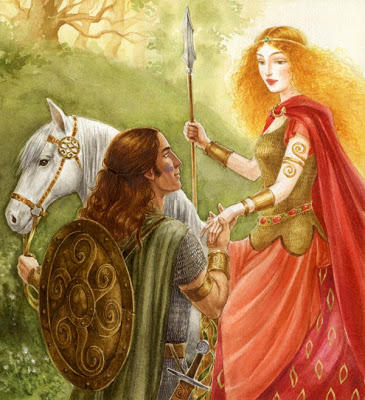
This story is beautiful, and yet, sad. Oisín was the son of Fionn mac Cumhaill (aka Finn Mac Cool, who was portrayed as a giant in folklore). While Fionn and the Fianna were hunting over in county Kerry, a beautiful woman on a white horse approached the group. When asked for her name, she said she was Niamh, and her father was the king of Tír na nÓg. She was looking for Oisín and wanted him to return to Tír na nÓg (the land of the young) with her. While Fionn was hesitant to let his son go, in fear he would never see him again, Oisín got on the horse with Niamh and left. He ended up marring Niamh and living in Tír na nÓg for three hundred years. But he was so happy that the time felt much shorter. He eventually wanted to go back to Ireland. Niamh warned him that if he left, he shouldn’t set foot on the soil of Ireland because he would never be able to return to Tír na nÓg ever again. When Oisín returned, he was shocked over how much had changed. He then saw some men trying to move a stone, and Oisín offered to assist. But as soon as he stepped off the horse, it galloped away and Oisín turned into a frail old man. He was taken to St. Patrick, who offered him comfort and care in his final days. Oisín was saddened to hear that 300 years had passed and everyone he knew was dead. He talked about Tír na nÓg and how beautiful it was. The legend still remains relevant to this day.
Pookas
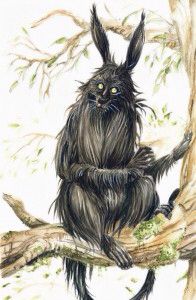
Pookas are one of the most feared creatures in Ireland. They are a type of fairy that thrive on mischief and creating havoc for humans. The word, “pooka”, comes from the Irish root word, “puca”, which means “goblin.” It is a shapeshifter that often takes the form of a dark horse. Apparently, if someone is drunk, the horse will offer them a ride home. The drunkard is essentially given the ride of its life as the Pooka gets enjoyment out of terrifying the inebriated rider. It has also been seen as a rabbit, a dog, or even an old man. They only appear at night, and they possess the gift of speech. What is interesting to note is that almost every county in Ireland has some variation of the Pooka legend. They are normally seen tearing down fences and bothering the animals. However, if they are in a bad mood, they could cause fires and call people out by name at night. If the person came out, then the Pooka carried them away. Pookas were also blamed for the numerous shipwrecks on the Irish coast under the belief that they were also messing with ships.
Queen Maedh
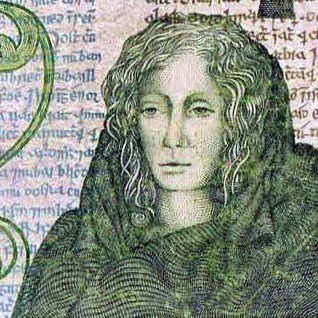
You could say this is where fact and fiction combine. She’s known by a few different names; Maedh, Medb, the list goes on. She was the queen of Connacht and found in the Ulster cycle of Irish mythology. If you look at pictures of her, she looks cunning, sassy, and ready to take over the world. Her father was believed to be the King of Ireland, and then became the King of Connacht, and then she took over the role from him. Her father married her off to Conchobar mac Nessa. She bore several children and had a few more husbands and bed partners after him. What is interesting about Maedh is that she was perceived to be some sort of goddess, and marriage to her meant that her husband would become the King of Ireland. She is truly one of the most famous figures in Ireland and her legacy lives on.
Children of Lir
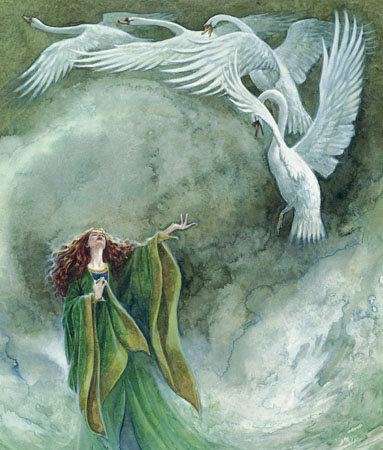
We can’t talk about Irish myths and legends without mentioning the Children of Lir, who can be found in the Mythogical Cycle. Their legend is supposedly the inspiration for the ballet, “Swan Lake.” The children’s father was King Lir (hence the name), and their mother, Aobh, died. The children were Aodh, Fionnghuala, Fiachra and Conn. To get over his wife’s death, Lir married his wife’s sister, Aoife. At first, she loved the children. But she eventually became jealous of how much her husband loved his children. What a concept, right? In a classic move of stepmother cruelty, she took the children to Lake Derravarragh in County Westmeath and put a spell on them while they were swimming. Aoife turned the children into swans and cursed them in this form for 900 years. The children kept their ability to speak during their curse and they would often sing on the lake. They remained at Lake Derravarragh for 400 years. Then, they went to the Sea of Moyle between Ireland and Scotland for 300 more years. Then, they went to Erris in County Mayo. They then returned to their home castle. Their father was long dead and the place was in ruins. The children were heartbroken. They returned to Erris, where they met St. Mochaomhóg, who eventually broke the curse. Some credit St. Patrick as well for breaking the curse. The cursed could have been broken earlier, but they never hear the sound of a Christian bell. When the curse broke, the children became an old woman and three old men. St. Mochaomhóg baptized the group, and they passed away in peace.
The Legend of Diarmuid & Grainne
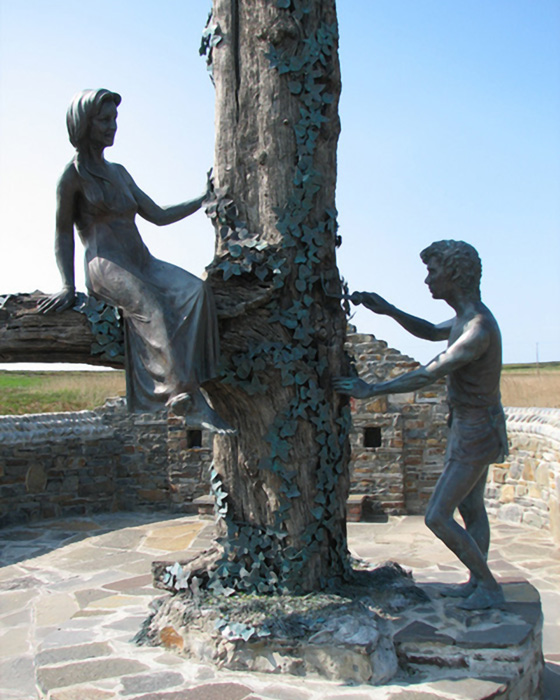
Here’s another Irish legend centering around Fin Mac Cool. The aging figure was seeking a second wife, and he fell for Grainne, who was the daughter of the King of Ireland, Cormac MacAirt. She initially agreed to the engagement, and then she met Diarmuid. They instantly fell in love. Grainne drugged the entire group during a celebration feast and told Diarmuid how she felt. However, the noble warrior didn’t want to betray his best friend, so he declined. But Grainne didn’t want to take no for an answer. So, she placed a spell on him and made him fall in love with her. The couple ended up running away together, with Finn and his men in pursuit. They would sleep in caves and basically live in hiding. Grainne eventually became pregnant with Diarmuid’s child. Eventually, a boar confront Diarmuid. A boar was the only thing that could kill the man. Protecting Grainne, who was heavily pregnant, Diarmuid was gored by the beast as he killed it with his sword. As he was dying, Finn and his men approached the couple. Grainne begged Finn to save Diarmuid by letting him drink the water from Fionn’s magical hands. Fionn refused, but eventually gave in after Oisin threatened to kill his father. But before Fionn could get the water, Diarmuid died.

